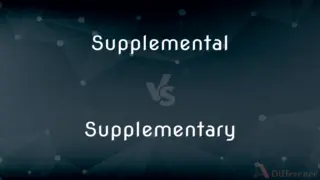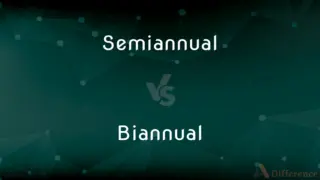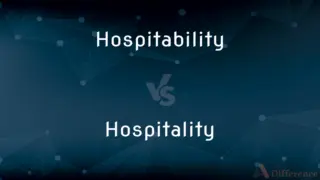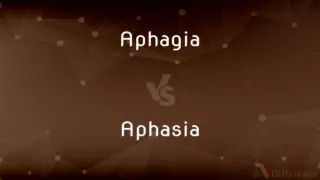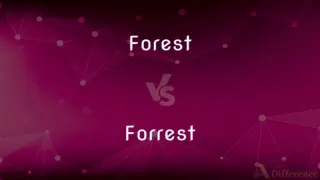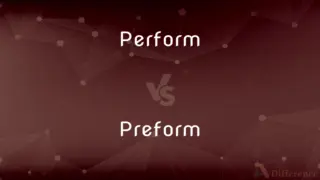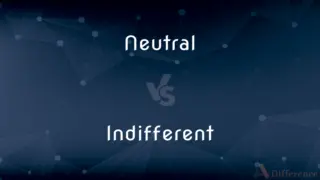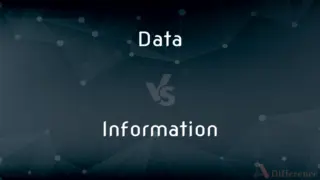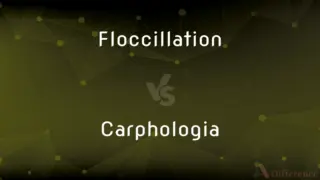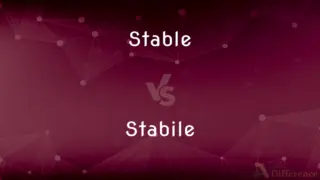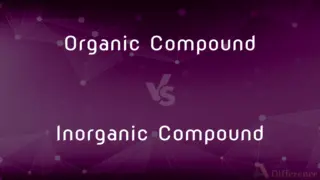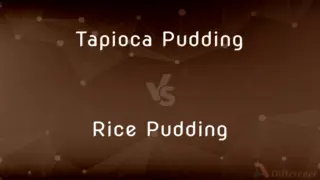Peristalsis vs. Segmentation — What's the Difference?
By Fiza Rafique & Urooj Arif — Updated on March 29, 2024
Peristalsis is a series of wave-like muscle contractions that move food through the digestive tract, while segmentation involves contractions that mix and break down the food.
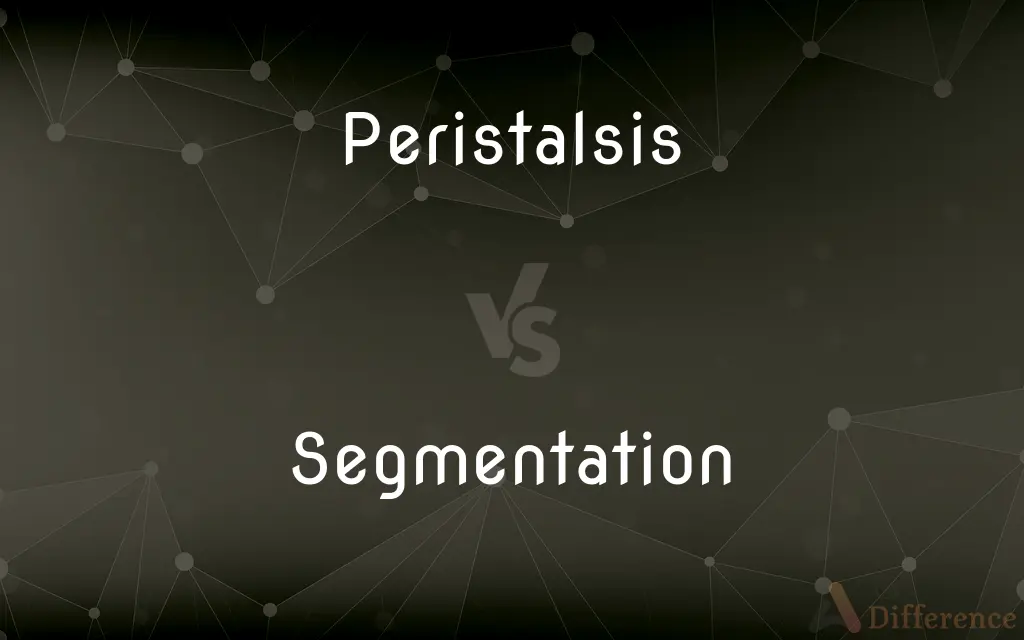
Difference Between Peristalsis and Segmentation
Table of Contents
ADVERTISEMENT
Key Differences
Peristalsis is a coordinated, rhythmic contraction of smooth muscles that propels food through the gastrointestinal tract, starting from the esophagus to the intestines. Whereas, segmentation is a process that mainly occurs in the small intestine and involves the contraction and relaxation of non-adjacent segments of the intestine. This action mixes the intestinal contents with digestive juices and facilitates absorption by constantly altering the environment around the intestinal walls.
While peristalsis is primarily concerned with moving contents along the digestive tract, segmentation's main purpose is to increase the interaction of food with the digestive enzymes and the absorptive surface of the intestines. On the other hand, peristalsis ensures that the digested substances continue their journey towards excretion.
Peristalsis involves a wave-like motion that is continuous and propels food particles in a single direction, from the mouth towards the anus. Conversely, segmentation movements are localized and do not follow a set path, focusing instead on mixing the contents within the digestive system to ensure thorough nutrient absorption and digestion.
The rate of peristalsis can be influenced by various factors, including the type of food consumed and the individual's physiological state. Segmentation, on the other hand, adjusts its intensity based on the composition of the intestinal contents, with a higher presence of nutrients leading to more vigorous mixing actions.
Both peristalsis and segmentation are essential for the digestive process, but they play distinct roles. Peristalsis ensures the forward movement of food and waste, while segmentation optimizes the process of digestion and absorption by thoroughly mixing the contents of the digestive tract.
ADVERTISEMENT
Comparison Chart
Primary Function
Propels food through the digestive tract
Mixes and breaks down food in the digestive tract
Location
Throughout the gastrointestinal tract
Mainly in the small intestine
Motion Type
Wave-like, coordinated contractions
Contraction and relaxation of non-adjacent segments
Purpose
Ensure forward movement of digestive contents
Enhance nutrient absorption and digestion
Trigger Factors
Type of food, physiological state
Composition of intestinal contents
Compare with Definitions
Peristalsis
A biological process observed in many animals.
Peristalsis is not unique to humans; it's found in various species for digestion.
Segmentation
Dependent on the presence of nutrients.
A nutrient-rich meal triggers more intense segmentation activity.
Peristalsis
The primary mechanism for moving digested food through the intestines.
After eating, peristalsis helps in the digestion process by moving food along.
Segmentation
Occurs by the contraction and relaxation of intestinal muscles.
Through segmentation, the small intestine maximizes contact with digested food.
Peristalsis
A rhythmic contraction of smooth muscles to propel contents in the gastrointestinal tract.
Swallowing triggers peristalsis to move food from the esophagus to the stomach.
Segmentation
Essential for breaking down complex food particles.
Segmentation plays a critical role in the digestion of fats and proteins.
Peristalsis
Influenced by dietary and physiological factors.
High-fiber foods can enhance peristaltic movement.
Segmentation
Helps in the efficient absorption of nutrients.
Without segmentation, nutrients in food might pass through the intestine unabsorbed.
Peristalsis
An involuntary process essential for digestion.
Even without our awareness, peristalsis continuously works to digest food.
Segmentation
A process of mixing intestinal contents for digestion.
Segmentation breaks down food particles for easier nutrient absorption.
Peristalsis
Peristalsis is a radially symmetrical contraction and relaxation (which is expansion) of muscles that propagates in a wave down a tube, in an anterograde direction. Peristalsis is progression of coordinated contraction of involuntary circular muscles, which is preceded by a simultaneous contraction of the longitudinal muscle and relaxation of the circular muscle in the lining of the gut.In much of a digestive tract such as the human gastrointestinal tract, smooth muscle tissue contracts in sequence to produce a peristaltic wave, which propels a ball of food (called a bolus before being transformed into chyme in the stomach) along the tract.
Segmentation
Division into segments.
Peristalsis
The wavelike muscular contractions of the digestive tract or other tubular structures by which contents are forced onward toward the opening.
Segmentation
(Embryology) See cleavage.
Peristalsis
(medicine) The rhythmic, wave-like contraction and relaxation of muscles so as to propagate motion, as of food in the digestive tract.
Segmentation
The act or an instance of dividing into segments
Peristalsis
Peristaltic contraction or action.
Segmentation
The state of being divided into segments
Peristalsis
The process of wave-like muscle contractions of the alimentary tract that moves food along
Segmentation
The partitioning of an image into groups of pixels
Segmentation
The act or process of dividing into segments; specifically (Biol.), a self-division into segments as a result of growth; cell cleavage; cell multiplication; endogenous cell formation.
Segmentation
(embryology) the repeated division of a fertilised ovum
Segmentation
The act of dividing or partitioning; separation by the creation of a boundary that divides or keeps apart
Common Curiosities
What is the main function of segmentation?
The main function is to mix the contents of the intestine to facilitate digestion and absorption.
Can peristalsis and segmentation occur simultaneously?
Yes, both processes can occur at different parts of the digestive system simultaneously.
Where does peristalsis occur?
It occurs throughout the gastrointestinal tract, from the esophagus to the intestines.
How does the body control peristalsis?
Peristalsis is controlled by the autonomic nervous system and various hormonal signals.
Why is segmentation important in the digestive process?
It's important for enhancing the efficiency of nutrient absorption and digestion.
Can disorders affect peristalsis?
Yes, various digestive disorders can impair peristaltic movements, leading to conditions like constipation.
How does segmentation differ from peristalsis?
Segmentation involves contractions that mix and break down food, unlike peristalsis, which propels food.
What influences the rate of peristalsis?
The rate can be influenced by the type of food consumed and the individual's physiological state.
What is peristalsis?
Peristalsis is the process of wave-like muscle contractions that move food through the digestive tract.
What triggers segmentation in the small intestine?
Segmentation is triggered by the presence of nutrients and the stretching of the intestinal wall.
How does fiber affect peristalsis?
Dietary fiber can enhance peristaltic movements by adding bulk to the digestive contents.
How do diseases impact segmentation?
Diseases can disrupt the normal segmentation process, affecting nutrient absorption and digestion.
Is peristalsis a voluntary process?
No, it is an involuntary process controlled by the body's autonomic nervous system.
What role does segmentation play in nutrient absorption?
It maximizes the contact between nutrients and the intestinal walls, improving absorption.
Can lifestyle choices affect peristalsis and segmentation?
Yes, diet, hydration, and exercise can influence both peristalsis and segmentation.
Share Your Discovery
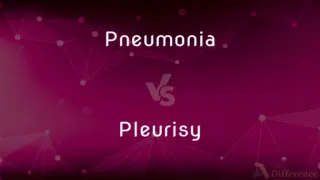
Previous Comparison
Pneumonia vs. Pleurisy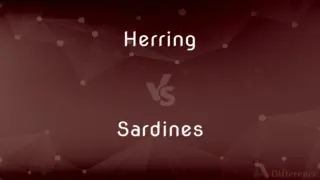
Next Comparison
Herring vs. SardinesAuthor Spotlight
Written by
Fiza RafiqueFiza Rafique is a skilled content writer at AskDifference.com, where she meticulously refines and enhances written pieces. Drawing from her vast editorial expertise, Fiza ensures clarity, accuracy, and precision in every article. Passionate about language, she continually seeks to elevate the quality of content for readers worldwide.
Co-written by
Urooj ArifUrooj is a skilled content writer at Ask Difference, known for her exceptional ability to simplify complex topics into engaging and informative content. With a passion for research and a flair for clear, concise writing, she consistently delivers articles that resonate with our diverse audience.

